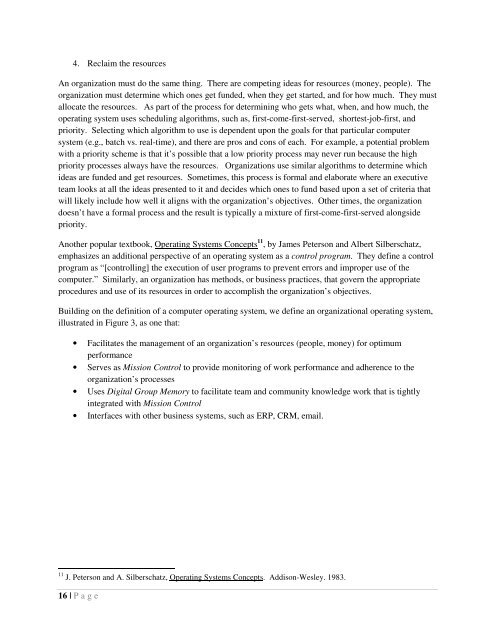The Organizational Operating System - cordin8
The Organizational Operating System - cordin8
The Organizational Operating System - cordin8
Create successful ePaper yourself
Turn your PDF publications into a flip-book with our unique Google optimized e-Paper software.
4. Reclaim the resources<br />
An organization must do the same thing. <strong>The</strong>re are competing ideas for resources (money, people). <strong>The</strong><br />
organization must determine which ones get funded, when they get started, and for how much. <strong>The</strong>y must<br />
allocate the resources. As part of the process for determining who gets what, when, and how much, the<br />
operating system uses scheduling algorithms, such as, first-come-first-served, shortest-job-first, and<br />
priority. Selecting which algorithm to use is dependent upon the goals for that particular computer<br />
system (e.g., batch vs. real-time), and there are pros and cons of each. For example, a potential problem<br />
with a priority scheme is that it’s possible that a low priority process may never run because the high<br />
priority processes always have the resources. Organizations use similar algorithms to determine which<br />
ideas are funded and get resources. Sometimes, this process is formal and elaborate where an executive<br />
team looks at all the ideas presented to it and decides which ones to fund based upon a set of criteria that<br />
will likely include how well it aligns with the organization’s objectives. Other times, the organization<br />
doesn’t have a formal process and the result is typically a mixture of first-come-first-served alongside<br />
priority.<br />
Another popular textbook, <strong>Operating</strong> <strong>System</strong>s Concepts 11 , by James Peterson and Albert Silberschatz,<br />
emphasizes an additional perspective of an operating system as a control program. <strong>The</strong>y define a control<br />
program as “[controlling] the execution of user programs to prevent errors and improper use of the<br />
computer.” Similarly, an organization has methods, or business practices, that govern the appropriate<br />
procedures and use of its resources in order to accomplish the organization’s objectives.<br />
Building on the definition of a computer operating system, we define an organizational operating system,<br />
illustrated in Figure 3, as one that:<br />
• Facilitates the management of an organization’s resources (people, money) for optimum<br />
performance<br />
• Serves as Mission Control to provide monitoring of work performance and adherence to the<br />
organization’s processes<br />
• Uses Digital Group Memory to facilitate team and community knowledge work that is tightly<br />
integrated with Mission Control<br />
• Interfaces with other business systems, such as ERP, CRM, email.<br />
11 J. Peterson and A. Silberschatz, <strong>Operating</strong> <strong>System</strong>s Concepts. Addison-Wesley. 1983.<br />
16 | P a g e


